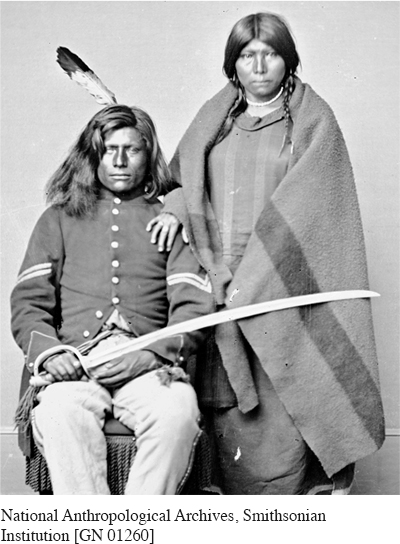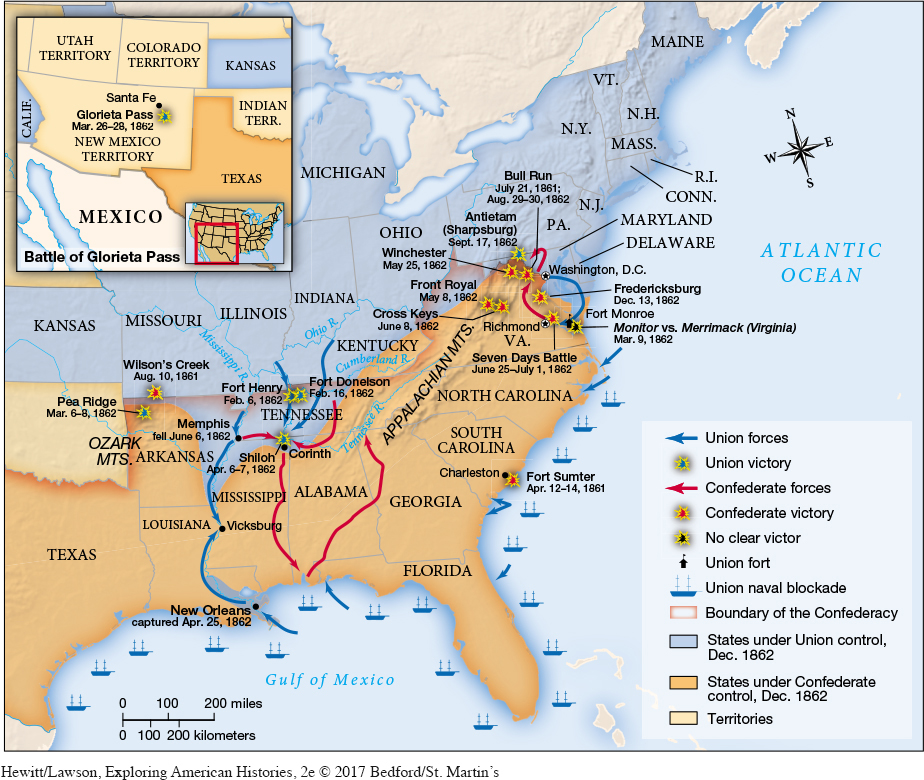The Wartime Roles of African Americans and Indians
The outbreak of war intensified debates over abolition. Some 225,000 African Americans lived in the free states, and many offered their services in an effort to end slavery. African American leaders in Cleveland proclaimed, “Today, as in the times of ’76, we are ready to go forth and do battle in the common cause of our country.” But Secretary of War Simon Cameron had no intention of calling up black soldiers.
Northern optimism about a quick victory contributed to the rejection of African American volunteers. Union leaders feared that whites would not enlist if they had to serve alongside blacks. In addition, Lincoln and his advisers were initially wary of letting a war to preserve the Union become a war against slavery, and they feared that any further threat to slavery might drive the four slave states that remained in the Union into the Confederacy. This political strategy, however, depended on quick and overwhelming victories; and with U.S. soldiers posted mainly on the western frontier and a third of officers joining the Confederacy, victories were few. Nonetheless a rush of volunteers allowed Union troops to push into Virginia while the Union navy captured crucial islands along the Confederate coast.
Wherever Union forces appeared, southern slaves began considering freedom as a possibility. Enslaved workers living near battle sites circulated information on Union troop movements. Then, as planters in Virginia began sending male slaves to more distant plantations for fear of losing them, some managed to flee and headed to Union camps. Many slave owners tracked fugitives behind Union lines and demanded their return. Some Union commanders denied slaves entrance or returned them to their masters. However, a few Union officers recognized these fugitives’ value: They knew the local geography well, could dig trenches and provide other services, and drained the Confederate labor supply. At the Union outpost at Fort Monroe, Virginia, in May 1861, General Benjamin Butler offered fugitive slaves military protection. He claimed them as contraband of war: property forfeited by the act of rebellion.
Lincoln endorsed Butler’s policy because it allowed the Union to strike at the institution of slavery without proclaiming a general emancipation that might prompt border states where slavery remained legal to secede. Congress expanded Butler’s policy in August 1861 by passing a confiscation act. It proclaimed that any owner whose slaves were used by the Confederate army would lose all claim to those slaves. Although it was far from a clear-cut declaration of freedom, the act spurred the hopes of northern abolitionists and many southern slaves.
While Northerners continued to debate African Americans’ role in the war effort, the Union army recruited a wide array of other ethnic and racial groups, including American Indians. Unlike blacks, however, Indians did not necessarily all support the Union. The Comanche negotiated with both Union and Confederate agents while raiding the Texas frontier for horses and cattle. The Confederacy gained significant support from slaveholding Indians who had earlier been removed from the Southeast. The Cherokee split over the war as they had over removal. General Stand Watie led a pan-Indian force into battle for the Confederates. Initially John Ross joined the Confederates as well, but later he led a group of Cherokee into Union army ranks alongside the Osage, Delaware, Seneca, and other Indian nations. Ely Parker, a Seneca sachem and engineer, became a lieutenant colonel in the Union army, serving with General Ulysses S. Grant.

Indians played crucial roles in a number of important early battles, particularly on the Confederate side. Cherokee and Seminole warriors fought valiantly with Confederates at the Battle of Pea Ridge in Tennessee in March 1862, but were defeated by a smaller but better supplied Union force. In August 1862 Indians contributed to the Confederate victory at the Second Battle of Bull Run and the following month participated in the bloodiest single day of battle in U.S. history at Antietam (Sharpsburg). The Confederate army recruited Mexican-American soldiers as well, hoping to gain control of the West’s gold and silver mines. But a Union victory gained by a troop of Colorado miners at Glorieta Pass near Sante Fe, New Mexico, ended that Confederate dream.
While both Union and Confederate armies recruited Indian regiments, African Americans were barred from enlisting as soldiers on either side. However, a series of Union military defeats helped transform the attitudes of northern whites. In the spring of 1862, Confederate general Stonewall Jackson won a series of stunning victories against three Union armies in Virginia’s Shenandoah Valley. That June and July, General Robert E. Lee fought Union forces under General George B. McClellan to a standstill in the Seven Days Battle near Richmond. Then in August, Lee, Jackson, and General James Longstreet joined together to defeat Union troops at the Second Battle of Bull Run (Map 13.1).

As the war turned against the North, the North turned against slavery. In April 1862 Congress had approved a measure to abolish slavery in the District of Columbia, symbolizing a significant shift in Union sentiment. During that bloody summer, Congress passed a second confiscation act, declaring that the slaves of anyone who supported the Confederacy should be “forever free of their servitude, and not again held as slaves.” In July Congress also approved a militia act that allowed African Americans to serve in “any military or naval service for which they may be found competent.”
Support for the 1862 militia act built on Union victories as well as defeats. In April 1862 a Union blockade led to the capture of New Orleans, while the Battle of Shiloh in Tennessee provided the army entrée to the Mississippi valley. There Union troops came face-to-face with slavery. Few of these soldiers were abolitionists, but many were shocked by what they saw, including instruments used to torture slaves. One Union soldier reported he had seen “enough of the horror of slavery to make one an Abolitionist forever.” Southern blacks also provided important intelligence to northern officers, making clear their value to the Union war effort.
Whether in victory of defeat, rising death tolls increased support for African American enlistment. The Battle of Shiloh was the bloodiest battle in American history to that point. Earlier battles had resulted in a few hundred or even a few thousand casualties, but with more than 23,000 casualties, Shiloh raised the carnage to a new level. As the war continued, such brutal battles became routine. The Union army would need every available man—white, black, and Indian—to sustain its effort against the Confederates.
Indian regiments had already proven themselves in battle, and African Americans soon followed suit. In October 1862 a group of black soldiers in the First Kansas Colored Volunteers repulsed Confederates at a battle in Missouri. In the South, white abolitionists serving as Union officers organized former slaves into units like the First South Carolina Volunteers in January 1863. A few months later, another black regiment—the Massachusetts Fifty-fourth—attracted recruits from across the North, including Frederick Douglass’s three sons. For the next two years, tens of thousands of African American soldiers fought valiantly in dozens of battles.
Exploring American HistoriesPrinted Page 421
Exploring American Histories Value EditionPrinted Page 311
Chapter Timeline